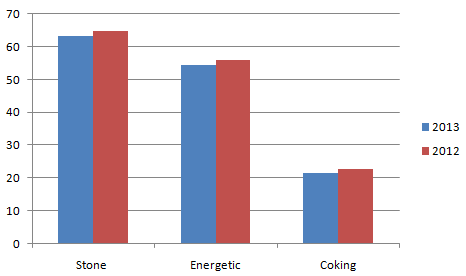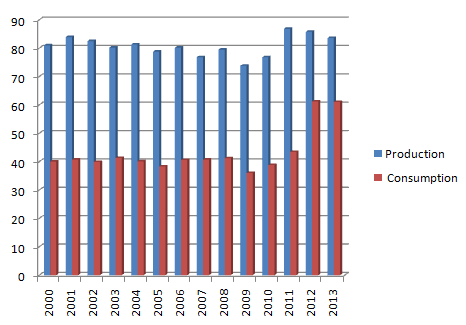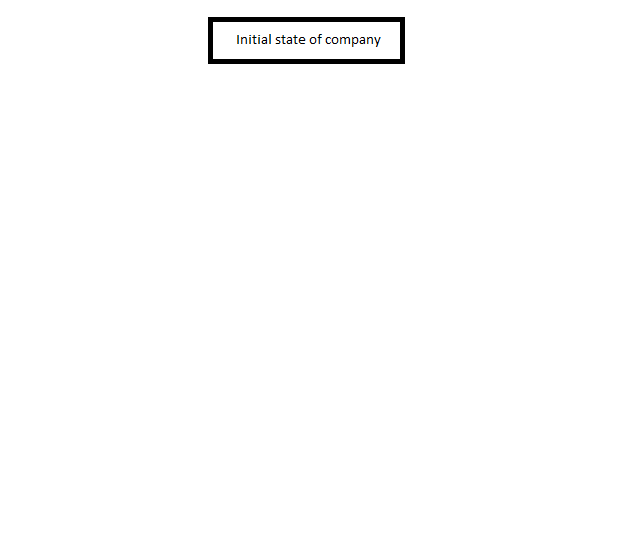Anna Bykh
Faculty of Management
Department of Economic Cybernetics
Speciality Economic Cybernetics
Modeling activities of coal mining enterprises in the conditions of restructuring
Scientific adviser: Ph. D., Professor Olga Dmitrieva
Abstract
Contents
- Introduction
- 1. Actuality of topic
- 2. Goals and subjects of research, expected results
- 3. A review of research and development
- 4. Characteristics of modern state of evolvement of coalmining productions in Ukraine
- 5. Creation of contextual diagram for coal mining process
- Conclusions
- References
Introduction
Ukraine possesses wide variety of energy sources: coal, nuclear fuel, waterpower, oil and gas. Nevertheless, coal is still the most available and stable energy source in the world, and is considered the main investor of the world power supply.
Coal industry in Ukraine is one of the most important in national economy. It takes the leading role in country’s metallurgic and fuel-energetic balance.In modern conditions of economic functioning, it’s highly important to ensure the increase of competitive ability of metallurgical industry and the energetically independent Ukraine.
1. Theme urgency
Coal industry in Ukraine is one of the most important in national economy. It takes the leading role in country’s metallurgic and fuel-energetic balance.In modern conditions of economic functioning, it’s highly important to ensure the increase of competitive ability of metallurgical industry and the energetically independent Ukraine [1]. In structure of metallurgical production during January – September of 2013 the significant grow of production occurred: cast iron – 21904 thousands of ton;steel – 24847 thousands of ton; rolled steel – 22016 thousands of ton, or, accordingly, 102,5%, 101% and 100,3% of actual production in the same period in 2012. At the same time, the decrease of the following products can be observed: concentrate, chark, tubes, ferroalloys [7, 10].
Tendencies of evolvement of energetics states that in structure of world reserve of organic fuel, coal takes 67%, oil – 18% and natural gas – 15%. In Ukraine, these data equals accordingly 95,4%, 2% and 2,6%. Probable reserves of coal are 117.5 billions of tons, of these industrial reserves at existing mines are 6.5 billions of tons, of which 3.5 billion of tons (54%) – energy coal. That is, these stocks allow stable produce 100 million tons of coal for 50 years, and at current rates of production, only mines of Donbass provide production for 100 years [7].
"Energy Strategy of Ukraine" predicted that consumption of coal by two largest industrial customers – thermal and coking industry, by 2030 will be 63 million tons and 39.8 million tons respectively. Therefore, one of the most important ways to increase the competitiveness of metallurgy and energy security of the country, is the increase in coal production, taking into account the presence of the respective resource base.
However, the dynamics of the major indicators of the state of the coal industry evidence of the development of the crisis in the industry. Reducing the number of operating mines (from 276 in 1991 to 153, from which 106 are state-owned, in 2012) and, respectfully, capacity of coal mining led to decrease in volumes of coal supplies to the domestic market by state-owned coal enterprises (from 57 billion of tons in 1997, to 28 billion tons in 2007) [10]).
The reason for this phenomenon is that the coal industry enterprises lose their fundamental importance, which requires restructuring. In the last 10–15 years, the restructuring is one of the main tools of reforming the coal industry. However, its low efficiency due to the lack of an effective system to manage this process and, in particular, the developed models, methods and information technologies.
2. Goals and subjects of the research, expected results
The purpose of this study is to develop methods and models of effective management and analysis of indicators of coal business in terms of restructuring.
To achieve this goal the following tasks were stated:
- Conduct analysis of coal mining enterprises in modern conditions.
- Define objectives of restructuring.
- Identify problems most often encountered in the process of restructuring.
- Conduct analysis of existing methods and models of management of enterprises in terms of restructuring.
- Combining the different directions of restructuring in a unified approach to the formation of recommendations for its implementation.
- Development of a model of evaluating the performance of scorecard for coal business in terms of restructuring.
Object of research: economic indicators of coal mining enterprises under restructuring.
Subject of research: models and methods for analyzing and optimizing performance of coal mining enterprises under restructuring.
As part of the master's work is planned to obtain relevant scientific results in the following areas:
- Development of a model assessment of the economic state of coal mining company.
- Determining the causes of the crisis phenomena.
- Modification of known assessment methods for state of the enterprise in terms of restructuring.
3. A review of research and development
Governance and restructuring of the coal industry are devoted to foreign and domestic scientists: N. A. Arkhipov, A. S. Astakhov, A. N. Doolin, A. P. Krasavin, G. L. Krasnyanskiy, K. K. Kuznetsov, S. S. Likhterman, N. Y. Lobanov, Y. N. Malyshev, E. V. Petrenko, A. A. Petrosov, M. A. Revazov, V. A. Kharchenko, V. A. Shestakov, M. A. Yastrebinskii etc.
Theoretical and methodological basis of the research work are economists – A.G.Aganbegyana, A. R. Belousova, E. E. Gavrilenkova, V. N. Leksina, A. V. Martynova,A. S. Nekrasova, R. M. Nureeva, S. G. Sinelnikova, A. V. Ulyukaeva, E. G. Yasina. Methodological basis of research experience are also Russian reforms – B. M. Genkina, L. A. Gordona, T. I. Zaslavskoy, R. I. Kapelyushnikova, V. V. Komarovskogo, T. M. Maleevoy, I. M. Model. Approaches, methods and models of Russian scientists working on the challenges of restructuring the coal industry – A. B. Kovalchuka, G. L. Krasnyanskogo, A. A. Makarova, Y. N. Malysheva, V. N. Popova, A. N. Rozhkova, A. B. Yanovskogo.
Modern trends in the restructuring of coal mining enterprises will require the development of new approaches, methods and models aimed at creating conditions not only for changing the governance structure, assets and expenses of the enterprise, but also the expansion of production.
4. Characteristics of modern state of evolvement of coalmining productions in Ukraine
In Ukraine there are three coal basin (Donetsk, Lviv-Volyn and Dnieper), the largest of which is the Donets Basin (87% of proved reserves in Ukraine). Geologically, most coal seams are thin (thickness of about 0.6–1.5 m.), which lie relatively deep (about 1000–1300 m.) and characterized as explosive because of the high gas content of coal rocks. Because of the explosion, mining Ukrainian coal is challenging, both technological and environmental points of view [4, 8].
Complicates the situation the market presence of large competitors on the foreign market, owning high-quality coal reserves, Germany, Poland, United States. Since the United States began to actively produce shale gasin 2012, the amount of coal in their domestic market has become excessive, resulting in an increase in supplies to foreign markets in 2012 by 29%. Another negative factor in the overall trend in the foreign market is a global slowdown in demand for steel.
On the positive factors affecting the coal industry in Ukraine, it should be highlighted: the gradual transition to coal as an energy source; desire to build a coal gasification plant with Chinese entrepreneurs; to reduce dependence on Russian gas [7].
Analyzing the dynamics of coal mining enterprises in Ukraine in January – November 2012 and 2013, Which is presented in Figure 1, It should be noted that coal production in Ukraine in January – November decreased by 3.2% to 76.16 million tons. Coking coal production decreased by 4.8% to 21.64 million tons, steam coal – by 2.6% to 54.51 million tons [7].

Figure 1 – Dynamics of coal mining enterprises in Ukraine in January – November 2012 and 2013
Coal producers, within the scope of management Minenergougol in January – September this year, reduced coal production by 7.4% – to 17.49 million tons. Coking coal production decreased by 8.2% – to 4.9 million tons, the energy – by 7%, to 12.59 million tons.
Analyze the dynamics of coal production and consumption in Ukraine in 2000–2013 years.

Figure 2 – Dynamics of coal production and consumption in Ukraine (million t)
5. Creation of contextual diagram for coal mining process
Restructuring of the coal industry – this is a new process for Ukraine. In scientific journals can note the presence of various definitions of restructuring
. It is interpreted in the narrow sense – as a change in the organizational structure of the industry, and that such a definition was the basis of the existing approaches to the restructuring of the coal industry in Ukraine.
But there is another interpretation – in the broadest sense, as a continuous process of adaptation of enterprise management (industry) to market conditions that are constantly changing, in order to ensure survival
and improve the competitiveness of enterprises. This process covers all activities (management, production, financial, etc.) and economic relations (including relations of the property) [4].
Specifically, M. D. Aistova identifies the following main stages of restructuring: full diagnostics company, analysis and concept development, the restructuring program, the implementation of the restructuring program [2]. Basically the authors are schematic sequence of stages, but the main drawback is the lack of consistency of individual stages of restructuring and directions to each other. Therefore, it is advisable to apply the process of restructuring in the form of the following successive stages:

Figure 3 – Stages of restructuring
In order to determine the background and approaches to the restructuring of the coal industry, it is necessary to understand the specific nature of the process and coal mining. For this, context diagram of the process of coal mining by using IDEF0 methodologywas developed.
IDEF0 notation was developed based on the methodology of structural analysis and design SADT (Structured Analysis and Design Technique), adopted as the U.S. standard and is used in many projects related to the description of enterprises. This makes it possible to use the methodology IDEF0 as a common language for the exchange of information between organizations, auditors and experts. IDEF0 is widespread and is, in particular, the standard in international organizations such as NATO and the IMF [9].
In IDEF0 model is constructed as a set of interacting works and functions. Functional orientation in this case is in principle. Functions of the system are analyzed independently from the objects on which they operate, which allows to accurately simulate the logic and interaction processes.
Each IDEF0 – chart contains blocks and arcs. Blocks represent functions of the simulated system. Arcs connect the blocks together and reflect the interaction and relationship between them.
IDEF0 standard requires that the chart was not less than three and no more than six units. These limits support the complexity of diagrams and models at a level accessible to read, understand and use.
Each side has a special unit with a very definite purpose. The left side of the unit is designed for inputs, the top – to control, right – for outputs, the lower – for mechanisms.This designation reflects the principles defined system: inputs are transformed into outputs, control limits or offeres the conditions for performing transformations, mechanisms show what and how the function performs.
Arrows represent some information and nouns. The standard IDEF0 distinguish five types of arrows.
Input – objects used and transformed the work to get the result (output). It is assumed that the work may have no input arrows. Arrow entry is drawn as a member of the left face of work.
Control – the control information of work actions. Usually control arrows carry information that indicates that the work should perform. Each work must have at least one arrow control portrayed as the entrance to the upper bound of work.
Output – objects, in which inputs are converted. Each work must have at least one exit arrow emanating from the right edge of work.
Mechanism – the resources, that perform work. Mechanism arrowsare portrayed as a member of the lower bound of the work. At the discretion of the analyst, arrow mechanism cannot be shown on the model.
At the first stage unit type black box

Figure 4 – General view of the system
Thus, the whole process of coal mining is represented as a black box
. Left on the block received inputs: orders, electricity, wood, water. Outputs of the block are: coal for sale.

Figure 5 – Decomposition of the first level
As a result of the decomposition, 4 process are allocated: preparation of formation, development of the reservoir, the rise of coal to the surface, as well as formation treatment.
Each of these units is also subject to decomposition:

Figure 6 – Decomposition of the second level (block Preparing reservoir
)

Figure 7 — Decomposition of the second level (block Development of formation
)

Figure 8 — Decomposition of the second level (block Lifting the coal to the surface
)

Figure 9 — Decomposition of the second level (block Redemption mining
)
Functional model developed in the future will serve as a basis for developing a simulation model of coal mining company activities in terms of restructuring..
Conclusions
This analysis reflects the contemporary problems accumulated in the coal industry, which largely affect other industries.
Restructuring of the coal enterprises is very important for Ukraine, because of this industry depends on energy security of the country.
We see that the simulation of the coal mining company activities is a complex and multifaceted task, due to the interaction of multiple processes occurred during the operation of the enterprise.
In future,it is planned to expand and improve the business model of a coal mining company in terms of restructuring.
In writing this essay master's work is not yet complete. Final completion: December 2015. Full text of the work and materials on the topic can be obtained from the author or his manager after stated date.
References
- Материал из «Википедии» – свободной энциклопедии. Режим доступа: http://ru.wikipedia.org
- Аистова М. Д. Реструктуризация предприятий: вопросы управления: Стратегии, координация структурных параметров, снижение сопротивления преобразованиям / М. Д. Аистова. – М.: Альпина, 2002. – 287 С.
- Бром А. Е. Динамическая модель потоковых процессов промышленного предприятия / Экономика и управление в машиностроении – 2009. – Т. 1, No 1, – С. 3–11.
- Бегичева Т. В., Скляренко А. А. Экономические проблемы реструктуризации угольной отрасли // Менеджер. – 2001, № 4 (16) – 16 С.
- Дудко В. А. Динамическое моделирование ситуационного управления промышленным предприятием: Автореферат диссертации на соискание учёной степени кандидата экономических наук. – Тамбов, 2004. – 17 С.
- Мухаметшина Л. Ф. Формирование стратегий повышения инвестиционной привлекательности предприятий // Вестник Казанского государственного финансово–экономического института – 2009. – 55 С.
- Ежегодный отчет Baker Tilly International по угольной отрасли Украины. Режим доступа: http://www.bakertilly.ua/media/Baker%20Tilly%20–%20Report_coal_industry_rus.pdf
- Петренко А. В., Кравченко В. С. О направлениях инвестирования реструктуризации угольных предприятий. Режим доступа: http://scilance.com/library/book/43277
- Новоселова О. В. Когнитивные технологии проектной деятельности. Методическое пособие для студентов. – 13 С.
- Министерство энергетики и угольной промышленности Украины.Режим доступа: http://www.dpvu.com.ua/
